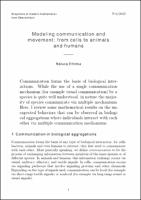| dc.contributor.author | Eftimie, Raluca | |
| dc.contributor.editor | Jahns, Sophia | |
| dc.contributor.editor | Cederbaum, Carla | |
| dc.date.accessioned | 2015-06-23T11:44:51Z | |
| dc.date.available | 2015-06-23T11:44:51Z | |
| dc.date.issued | 2015 | |
| dc.identifier.uri | http://publications.mfo.de/handle/mfo/449 | |
| dc.description.abstract | Communication forms the basis of biological interactions. While the use of a single communication mechanism (for example visual communication) by a species is quite well understood, in nature the majority of species communicate via multiple mechanisms. Here, I review some mathematical results on the unexpected behaviors that can be observed in biological aggregations where individuals interact with each other via multiple communication mechanisms. | en_US |
| dc.language.iso | en_US | en_US |
| dc.publisher | Mathematisches Forschungsinstitut Oberwolfach | en_US |
| dc.relation.ispartofseries | Snapshots of modern mathematics from Oberwolfach; 6/2015 | |
| dc.rights | Attribution-NonCommercial-ShareAlike 3.0 Unported | * |
| dc.rights.uri | http://creativecommons.org/licenses/by-nc-sa/3.0/ | * |
| dc.title | Modeling communication and movement: from cells to animals and humans | en_US |
| dc.type | Article | en_US |
| dc.identifier.doi | 10.14760/SNAP-2015-006-EN | |
| local.series.id | SNAP-2015-006-EN | |
| local.subject.snapshot | Numerics and Scientific Computing | |
| dc.identifier.urn | urn:nbn:de:101:1-201505123958 | |
| dc.identifier.ppn | 1656727765 | |


